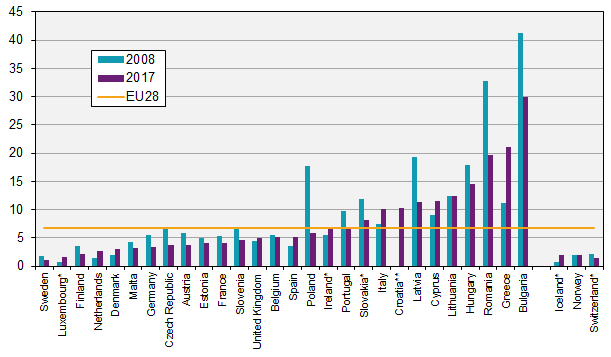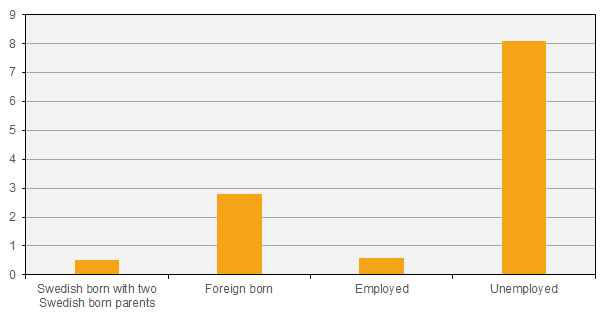Living Conditions Survey (ULF/SILC)
Sweden has the lowest rate of severe material deprivation in Europe
Statistical news from Statistics Sweden 2018-10-16 9.30
In Sweden, roughly one percent of the population lives in conditions of severe material deprivation, according to the EU definition. The EU average is 7 percent. Foreign born persons and unemployed persons to a larger degree live in conditions of severe material deprivation than Swedish born persons with two Swedish born parents, and compared with those who are in work.
In connection with the United Nations International Day for the Eradication of Poverty on 17 October, Statistics Sweden is publishing some of the indicators used by the European Union to monitor the risk of poverty and social exclusion.
Sweden and Switzerland reported the lowest rates in Europe, one percent, of the population living in conditions of severe material deprivation. Bulgaria and Greece reported the highest rates, 30 percent and 21 percent respectively in 2017.
Severe material deprivation means the inability to afford the expenses of at least four of nine items. For example, the inability to pay unexpected expenses, afford adequate heating of a dwelling, and an inability to make payment arrears.
The share of people living in Sweden in conditions of severe material deprivation has remained stable in recent years at one percent. This corresponds to roughly 100 000 materially deprived people in Sweden in 2017.

Source: Eurostat, EU-SILC. * The latest data refer to 2016. ** Data is missing for Croatia in 2008.
In Sweden, severe material deprivation is most common among unemployed persons. Among unemployed persons, eight percent – compared with one percent among employed persons – live in conditions of severe material deprivation. It is even more common among foreign born persons to live in conditions of severe material deprivation than among Swedish born persons with two parents born in Sweden – three percent compared with barely half a percent.

Source: Eurostat, EU-SILC.
Other results from the EU-SILC
- In Sweden, approximately nine percent of the population cannot afford a one-week holiday away from home. This is the lowest percentage in the European Union. In many countries, more than one out of three households cannot afford a holiday away from home.
- In Sweden, 13 percent of the population face problems of crime, violence or vandalism in their neighbourhood. This percentage is higher than in other Nordic countries and has increased slightly in Sweden in recent years.
- Roughly 16 percent of persons aged 65 and older in Sweden have an annual income after tax below the at-risk-of-poverty threshold. This proportion is slightly higher than the EU average. Among those aged 75 years and older, the corresponding share is roughly 22 percent for Sweden and roughly 16 percent for the EU on average.
Definitions and explanations
Severe material deprivation means the inability to afford a certain standard of living. This is measured by examining whether people are able to pay unexpected expenses, a one-week annual holiday, a meal involving meat, chicken or fish (or vegetarian equivalent) every second day, adequate heating of a dwelling, durable goods, such as a washing machine, a colour television set, telephone, and car, and not being confronted with payment arrears (mortgage or rent, utility bills, hire purchase instalments, or other loan payments). A severely materially deprived person is unable to afford at least four of these nine items. This measure is one of three overall measures followed up annually by the EU with a view to decrease the number of people at risk of poverty or social exclusion in Europe by 2020.
The EU’s risk of poverty indicator is a relative measure of income poverty. According to this definition, an individual with a disposable income (salary, wage, pension, contributions, and so on) below 60 percent of the country’s median income is at risk of poverty. This indicator does nor measure low standard of living or poverty, but rather low income in relation to other people in the country.
Next publishing will be
2018-11-07 at 09:30.
Statistical Database
More information is available in the Statistical Database
Feel free to use the facts from this statistical news but remember to state Source: Statistics Sweden.
